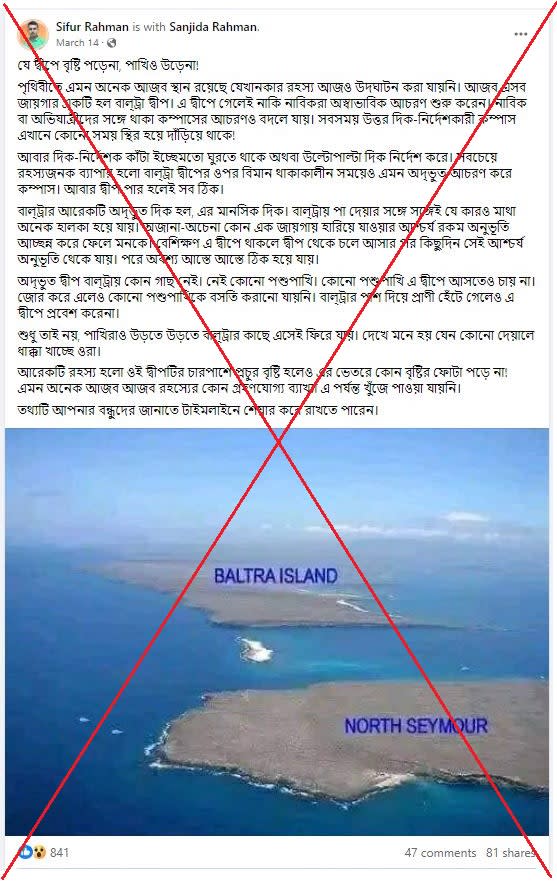Posts falsely claim Galapagos island has 'no plants, animals or rainfall'
Baltra Island in the Galapagos -- the famous Ecuadorian archipelago that inspired Charles Darwin's theory of evolution -- is home to plants and unique animals found nowhere else in the world, contrary to false online posts and media reports shared in March 2024. The islet has historically recorded low rainfall throughout the year, contradicting an additional misleading claim that it receives no rain.
"The island where rain does not fall, birds do not fly," read the caption of a Bengali-language Facebook post published on March 14, 2024.
Part of the post’s caption continued: "There are no trees on the strange island of Baltra and no animals. Animals pass by Baltra but do not enter the island."
"Another mystery is that even though there is a lot of rain around the island, no rain falls on it!"

The post -- shared more than 80 times -- included a Google satellite image of Baltra and neighbouring North Seymour Island in Ecuador's Galapagos archipelago.
The same image was shared with a similar false claim on Facebook here and here; as well as in some Bengali media reports here and here.
Baseless claim
Dr M Shahidul Islam, a professor of Geography & Environment at the University of Dhaka told AFP that the island's geographical location means it has a relatively harsh environment, but is home to notable biodiversity (archived here).
"It is a geographical entity with a harsh environment, but has everything including plants and animals," he said.
M Manzurul Hassan, a faculty at the Department of Geography and Environment at Jahangirnagar University, said the claim shared online about the island is untrue (archived here).
"Being a territory in the volcanic region, the island has a drier environment with some salinity issues which means it has fewer plant and animal species than other topical islands," he said.
Baltra Island is a part of the Galapagos archipelago, a UNESCO World Heritage site renowned for its unusual plant and animal life found nowhere else in the world -- including marine iguanas, flightless cormorants, giant tortoises and huge cacti -- that inspired Charles Darwin's theory of evolution (archived here and here).
Also known as South Seymour, the island is flat and arid, but the United Kingdom-registered Galapagos Conservation Trust states it is "studded with cacti and Palo santo trees" (archived here and here).
The charity adds that visitors are likely to spot some of the archipelago's iconic species, including Galapagos sea lions, land iguanas and Darwin's finches.
Photos and Street View images of the island on Google maps show dry, flat scrubland:
According to global bird database Avibase, 94 species have been found on the island (archived here).
Ecuador's Ministry of the Environment, Water and Ecological Transition reported here it had discovered a new colony of blue-footed booby birds on the island (archived here).
Rain
According to an article published by France-based travel site Where and When, the island enjoys a mild climate all year around, with a maximum of 113 millimetres of rain in February and a minimum of three millimetres of rain in the months from August to November (archived here).
Ecuador's national meteorological agency INAMHI posted last February about heavy rainfall in Baltra island (archived here).
